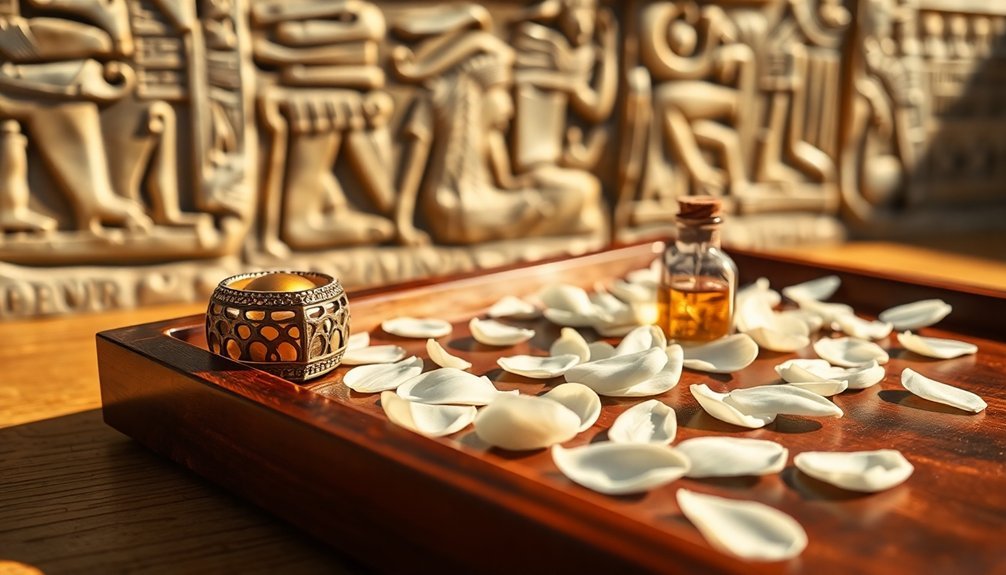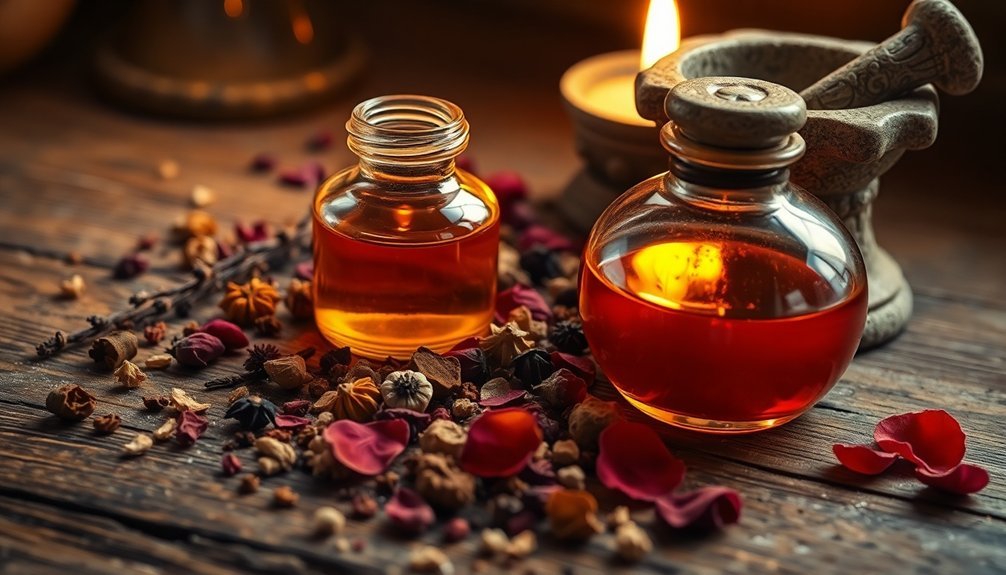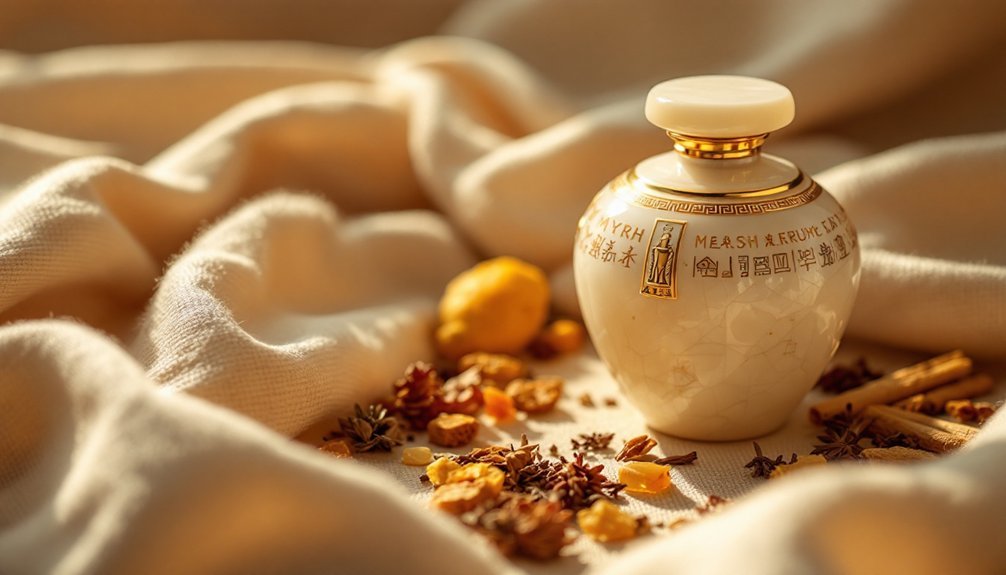Ancient Egypt's perfume-making techniques offer timeless methods you can still use today. These include cold-pressing essential oils at precise temperatures, blending beeswax with precious resins, extracting fragrances through enfleurage with animal fats, preserving scents in alabaster vessels, and macerating ingredients in carrier oils. From spiritual ceremonies to daily wear, these five techniques created luxurious solid perfumes that shaped the foundations of modern fragrance crafting. These ancient secrets await your discovery.
The Sacred Art of Cold-Pressed Essential Oils

While modern perfumery relies heavily on synthetic compounds, ancient Egyptians mastered the art of cold-pressed essential oils as early as 4500 BC.
You'll find their techniques were remarkably sophisticated, using mortars and pestles to extract precious fragrances from flowers, herbs, and resins.
The process required careful temperature control, heating mixtures to 65°C before cooling them to preserve their delicate aromas.
Ancient Egyptian perfumers mastered precise heating and cooling techniques to capture and protect the essence of precious fragrances.
Without alcohol as a carrier, these perfumes produced subtle scents that demanded close proximity to appreciate.
Pharaohs and priests cherished these oils not just for their fragrance but for spiritual and medicinal purposes too. The hot Egyptian climate made scented oils particularly valuable for both practical and ceremonial use.
The Egyptians' expertise with cold-pressing influenced civilizations through trade, while their use of materials like jasmine, myrrh, and cedarwood created complex, lasting aromas that would define luxury for millennia.
Blending Natural Waxes With Precious Resins
A delicate dance of wax and resin defined ancient Egypt's solid perfume creations. You'll find that artisans masterfully combined beeswax with plant-based oils, then carefully integrated precious resins like myrrh and frankincense through precise heating processes.
The famous Kyphi perfume exemplifies this intricate blend, where honey and cinnamon merged with sacred resins to create an enchanting fragrance that's still revered today. Ancient priests considered these aromatic blends to be the sweat of Ra, viewing them as divine gifts from their sun god.
You'd discover these luxurious blends stored in elaborate alabaster or ceramic vessels, symbolizing both wealth and divine connection.
What makes these ancient techniques remarkable is how they've shaped modern perfumery. The Egyptians' method of combining natural waxes with resins didn't just preserve the fragrance – it created a spiritual experience that influenced cultures across the Mediterranean and continues to inspire contemporary solid perfume crafting.
Traditional Egyptian Enfleurage Method

Delicate flower petals pressed into rich animal fats reveal the essence of traditional Egyptian enfleurage. You'll find this ancient technique was essential for extracting fragrances without heat damage, particularly from jasmine and lavender blooms. The Egyptians combined these delicate extracts with sacred ingredients like myrrh, frankincense, and exotic spices. Ancient Egyptian Scent Makers were highly respected professionals who carefully guarded their perfume recipes and techniques.
| Process Step | Key Components |
|---|---|
| Base Layer | Animal Fats/Lard |
| Flora Selection | Jasmine/Lavender |
| Enhancement | Myrrh/Frankincense |
| Storage | Alabaster Vessels |
When you're working with enfleurage, you'll need to follow precise timing and methods, just as the ancient Egyptians did during their spiritual ceremonies. They'd incorporate prayers and offerings while using mortars and pestles to blend their sacred ingredients, believing these perfumes held powerful healing properties.
Ancient Alabaster Preservation Technique
Skilled Egyptian artisans mastered the preservation of precious perfumes through their ingenious use of alabaster vessels. The stone's chemical composition of calcium carbonates created an ideal storage environment, protecting valuable fragrances from deterioration.
You'll find that ancient Egyptians specifically chose alabaster for its unique properties in perfume preservation:
- The stone's natural porosity helped regulate temperature and humidity, preventing deformation of the contents.
- Alabaster's chemical structure resisted water penetration, keeping moisture from compromising the perfumes.
- The material's 3.0 Mohs hardness provided enough durability while remaining workable for craftsmen.
Modern analysis through petrographical examination and geotechnical methods has revealed why these vessels were so effective, leading conservators to use silane-based products to preserve these ancient containers for future generations.
Time-Honored Maceration Process With Carrier Oils

While modern perfumers rely on industrial processes, ancient Egyptians mastered the art of maceration using carrier oils to create their cherished fragrances.
You'll find they primarily used balanos oil, known for its exceptional scent-absorbing properties, while lower classes opted for more affordable castor oil alternatives.
The process wasn't quick – it often took weeks as they layered flowers, herbs, and spices in heated clay vessels.
They'd combine these botanicals with carrier oils, allowing time for the aromatic compounds to fully release.
Sometimes, they'd add animal-based ingredients like musk or ambergris for unique scent profiles.
For enhanced potency, they'd repeat the maceration process multiple times, adding fresh botanical layers to achieve the desired fragrance intensity.
The result? Long-lasting, oil-based perfumes that retained their scent far longer than today's alcohol-based varieties.
Frequently Asked Questions
How Long Did Ancient Egyptian Solid Perfumes Typically Last Before Losing Their Scent?
While you'll find limited historical data on exact durations, ancient Egyptian oil-based solid perfumes likely lasted 6-15 hours on skin, though their shelf life could extend considerably when stored in sealed alabaster containers.
Did Ancient Egyptians Use Different Perfumes for Men and Women?
You won't find clear evidence of gender-specific perfumes in ancient Egypt. While perfumes were widely used by both men and women, their choices were based on occasion and personal preference rather than gender.
What Tools Were Used to Apply Solid Perfumes to the Body?
You'll find they used spatulas, elaborate spoons, and wooden or bamboo applicators for precise perfume application. For daily use, fingers were common, while the wealthy often preferred finely crafted tools for their perfumes.
Could Ancient Egyptian Perfumes Be Used as Medicine or Healing Remedies?
You'll find ancient Egyptian perfumes were indeed used as medicine. They contained anti-inflammatory ingredients like frankincense and myrrh, and you could use them for healing rituals, body purification, and therapeutic treatments.
How Did Weather Conditions Affect the Production of Solid Perfumes?
You'll find that hot desert conditions directly influenced perfume-making by requiring stable oils and resins. You'd need special storage containers and heat-resistant ingredients to prevent your fragrances from degrading or evaporating too quickly.





Leave a Reply